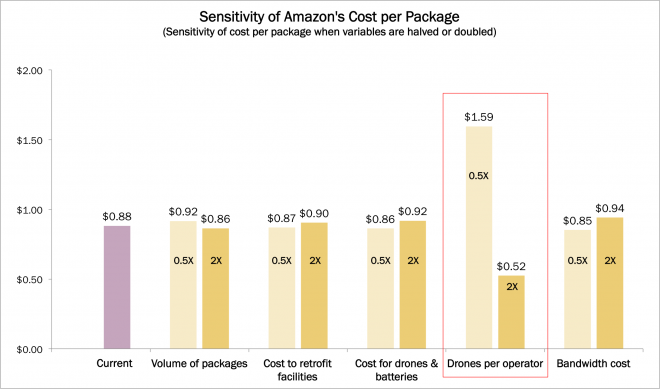
Since its initial publication, ARK has scrutinized the assumptions and refined the estimates. Even with more conservative figures, ARK finds that Amazon could offer drone delivery for $1 and still turn a profit. Here are the assumptions, broken down into three parts:
Part 1: Estimated Volume of Packages Shipped by Prime Air
Amazon [AMZN] is on track to reach $60 billion in revenues for 2015 in North America.[1] Amazon’s average order size is roughly $60 for two items,[2] implying one billion orders and two billion items delivered per year. A subset of these packages would fit the requirements for drone delivery.
- Packages must weigh fewer than five pounds; and
- The delivery distance must be within ten miles of Amazon’s facilities.
Jeff Bezos has said that 86% of Amazon’s deliveries weigh fewer than five pounds. ARK assumes that 25% of these deliveries will be within ten miles of an Amazon facility, and fit Amazon’s target market for Prime Air. If each item is delivered separately, roughly 400 million packages would be eligible for drone shipment.
Part 2: Assumption for Amazon’s Capital Costs
ARK estimates that Amazon will need to spend about $50 million on infrastructure for the Prime Air program. This covers the cost to retrofit existing fulfillment centers with additional space, equipment, and software. Amazon has 75+ fulfillment centers in the US.[3]
The cost for small drones is relatively low. The drone that Amazon shows in its demo videos is a small octocopter, which costs $1,000 – $3,000 on average.[4] At an average of 30 deliveries per drone per day, 30,000- 40,000 drones would be needed at current sales levels. Amazon could stock roughly 50,000 extra batteries costing $200 [5] each to allow swapping [6] between deliveries. In total, drones and batteries would cost roughly $80 million, bringing the total capital cost to about $130 million, relatively low for a transformation of retail logistics.
Part 3: Estimated Operating Costs of Prime Air
ARK estimates that Prime Air’s biggest operational expense will be labor. Amazon operators will have to monitor drone activity, occasionally intervening manually for remote landings for safety reasons. If they were to work in two eight-hour shifts, each responsible for 10-12 drones, roughly 6,000 operators would be needed.[7] Salaries could be roughly $50,000 [8] a year per operator, totaling $300 million per year in annual labor cost.
To facilitate remote landings, drones would need to stream video back to Amazon’s facilities. ARK assumes that data will cost roughly $6.30 per GB per month, driving total bandwidth cost to roughly $25 million per year. A Verizon plan for 100 GB of data per month costs $790. Assuming a 20% wholesale discount, data would cost about $6.30 per GB.[9]
Maintenance and fuel make up the additional operating cost. Maintenance on infrastructure could be roughly 10% of the capital cost, and maintenance on drones close to 20% [10] of the purchase cost. Total maintenance costs therefore could approach $15 million per year. In addition, the retail price of electricity should be roughly 10 cents per kWh, and if every delivery were to deplete a full battery, fuel would cost roughly $4 million per year. In total, operating costs could amount to almost $350 million per year.
Summary
With about $130 million in capital costs and $350 million in operating costs, Amazon’s cost per package for delivery would be roughly 88 cents.[11] At a 15% discount rate, Amazon could deliver 400 million packages for $1 profitably.[12] That said, Amazon could choose to deliver the service free of charge for Prime members.
If ARK’s assumptions are off base, most variables will not change Amazon’s cost per package meaningfully, with the exception of labor cost (as shown below). If the number of drones each operator could control were to halve or if drone operators’ salaries were much higher than anticipated, Amazon’s costs could exceed $1 per package.


 Actively Managed Equity
Actively Managed Equity Overview: All Strategies
Overview: All Strategies Investor Resources
Investor Resources Indexed Equity
Indexed Equity Private Equity
Private Equity Digital Assets
Digital Assets Invest In The Future Today
Invest In The Future Today
 Take Advantage Of Market Inefficiencies
Take Advantage Of Market Inefficiencies
 Make The World A Better Place
Make The World A Better Place
 Articles
Articles Podcasts
Podcasts White Papers
White Papers Newsletters
Newsletters Videos
Videos Big Ideas 2024
Big Ideas 2024


